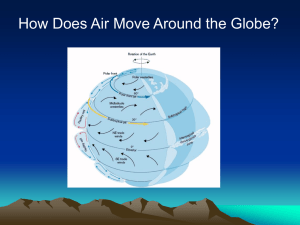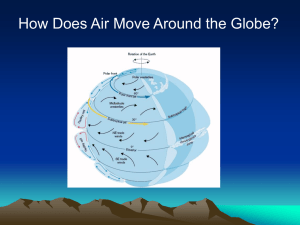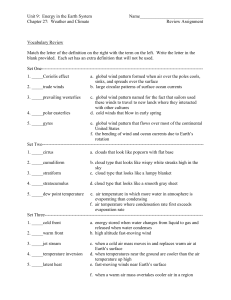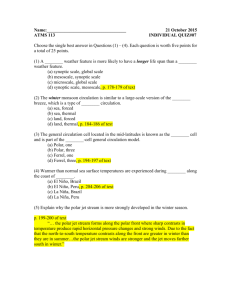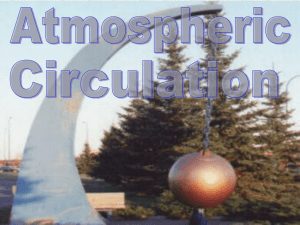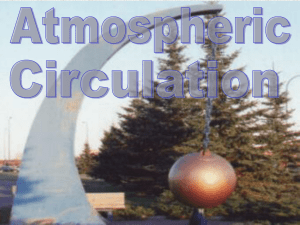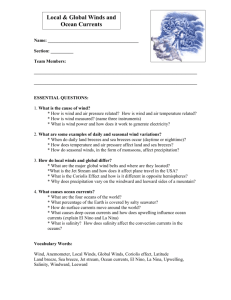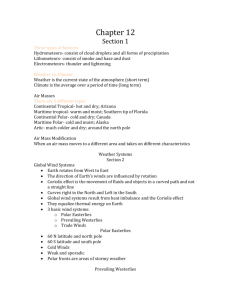Zonal winds
advertisement
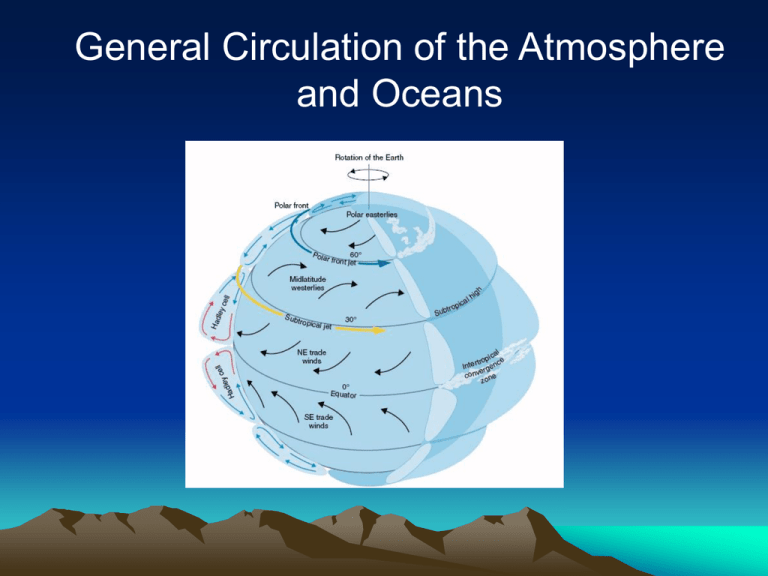
General Circulation of the Atmosphere and Oceans Before we start … • Assignment IV: 7 full scores, 16 9s, 11 8s • Assignment V: 28 full scores, 2 9s, 1 8s. • Midterm II: 41-51: 9 (one 51 and one 50!) 31-40: 17 (try to do better next time!) 21-30: 7 (try to do better next time!) Introduction • Well-defined pressure patterns exist across the globe • These define the general circulation of the planet • In describing wind motions: – Zonal winds: flow parallel to lines of latitude – Meridional winds: flow parallel to lines of longitude • The general circulation of the atmosphere may be examined through a three-cell model Primary Highs and Lows Equatorial low Subtropical high Subpolar low Polar high Annual mean precipitation (heating) Tropical rainfall Extratropical stormtrack Three-cell model Zonal mean circulation Each hemisphere is divided into 3 distinct cells: Hadley Cell Ferrel Cell Polar Cell Vertical structure and mechanisms Polar Cell (thermal): Driven by heating at 50 degree latitude and cooling at the poles Ferrel Cell (dynamical): Dynamical response to Hadley and polar cells Hadley Cell (thermal): Heating in tropics forms surface low and upper level high air converges equatorward at surface, rises, and diverges poleward aloft descends in the subtropics Vertical structure of temperature Two characteristics: • Horizontally uniform in the tropics • Steep gradient in the extratropics Vertical structure of zonal wind Two characteristics: • Westerly winds in the extratropical troposphere • Jet streams: local maximum of winds Westerly winds in the extratropical troposphere • The existence of the upper level pressure gradient air is being pushed toward poles Coriolis effect deflects upper air (to the right) Westerlies dominate upper troposphere • Strongest during winter thermal gradient is large • Explains why storms move eastward, flight times The Jet Streams • Caused by steep temperature gradients between cold and warm air masses • Polar front - marks area of contact, steep pressure gradient polar jet stream • Low latitudes subtropical jet stream • Stronger in winter, affect daily weather patterns Annual mean 200 mb winds Subtropical jet stream Polar jet stream A Jet Stream seen from satellite The subtropical jet is seen as a band of clouds extending from Mexico on an infrared satellite image Semi-permanent Surface Pressure Cells • Instead of cohesive pressure belts circling the Earth, semipermanent cells exist January • Low: Aleutian, Icelandic, Tibetan • High: Siberian, Hawaiian, Bermuda-Azores • Cells are either dynamically or thermally produced, and fluctuate in strength and position on a seasonal basis • Subtropical highs are often associated with deserts July Annual mean 850mb winds Horse latitudes General circulation of the oceans • Ocean currents – horizontal water motions • Transfer energy and influence overlying atmosphere • Currents result from frictional drag caused by wind Ekman Spiral • Water moves at a 45o angle (right) in N.H. to prevailing wind direction • Due to influence of Coriolis effect • Greater angle at depth Global Ocean Circulation • Surface currents mainly driven by surface winds • North/ South Equatorial Currents pile water westward, create the Equatorial Countercurrent • western ocean basins –warm poleward moving currents (example: Gulf Stream) • eastern basins –cold currents, directed equatorward Ocean upwelling • is an oceanographic phenomenon that involves wind-driven motion of dense, cooler, and usually nutrient-rich water towards the ocean surface, replacing the warmer, usually nutrient-depleted surface water. • Coastal upwelling: Due to Coriolis effect • Equatorial upwelling: Due to Coriolis effect Deep Water Circulation Figure 6.23 Christopherson, 2003 Summary • • • • Primary high and lows Three-cell model. Mechanism for each cell Two characteristics of temperature structure Two characteristics of wind structure. Why does westerly winds prevail in the extratropical troposphere? What cause the jet streams? • What drives the ocean currents? In the case of Ekman spiral, what is the direction of surface current relative to surface wind? Two types of ocean upwelling
